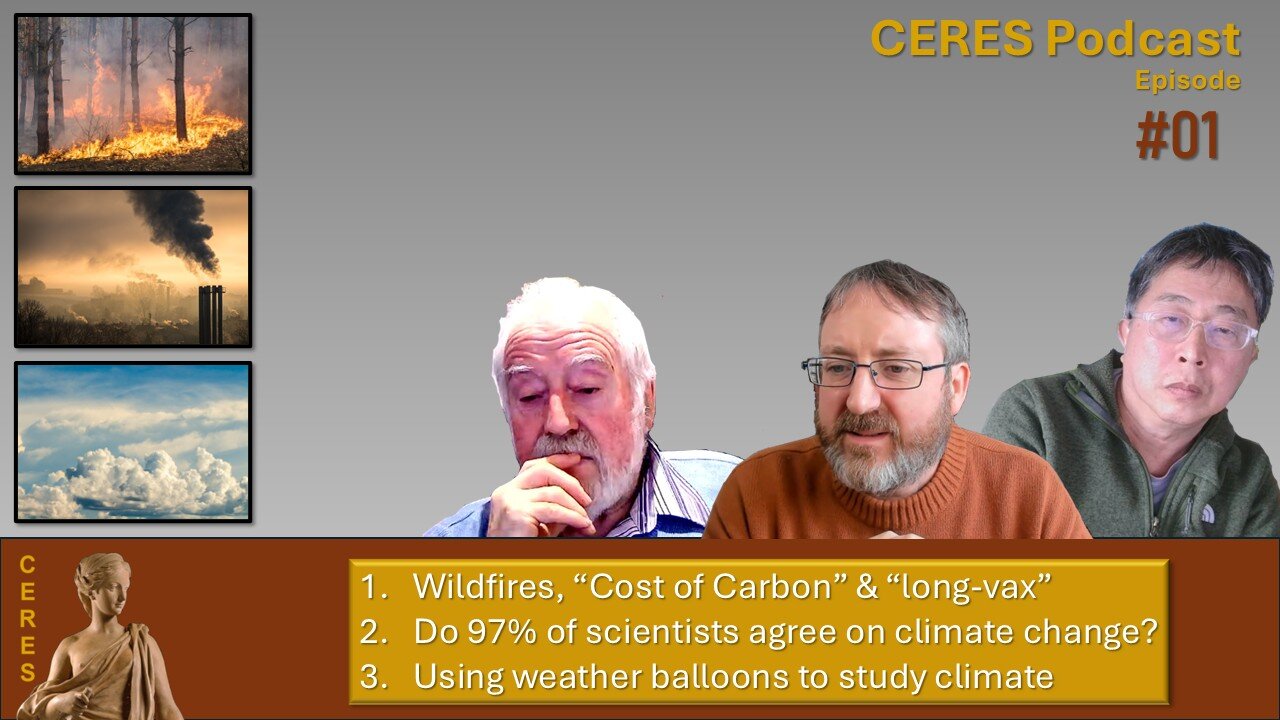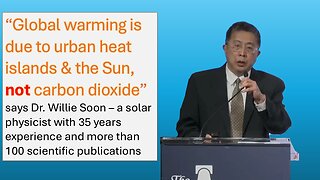Premium Only Content

Wildfires to weather balloons; Debunking the “97% of scientists agree” myth | CERES Podcast Ep#01
In this inaugural episode of the CERES Podcast, the CERES team leaders (Dr. Willie Soon, Dr. Ronan Connolly & Dr. Michael Connolly) cover everything from North American forest fires to using weather balloons to understand how the Earth’s atmosphere behaves.
In Part 1 – the “science news round-up” – we discuss three new papers that caught our attention in the last two weeks: a) a study of forest fire activity of the past 400 years; b) a paper that shows the “Social Cost of Carbon” needs to be majorly reduced from the US EPA’s current estimates; c) a preprint describing “long-vax”.
In Part 2, we take a deep dive into the origins of the claim that “97% of scientists agree on climate change”. We show that they just agree that “climate changes”, and there is actually a lot of disagreement over how much is due to human activity vs. natural factors.
In Part 3, we describe some of the published research of the CERES team. In this episode, Michael, will focus on the use of “molar density” to analyze weather balloons and the surprising previously undiscovered insights this technique is revealing about the Earth’s atmosphere.
🔹 🔹 🔹 🔹
Chapters:
00:00 Introduction to the new CERES podcast
05:27 Part 1: Science news
05:49: North American forest fires were more widespread in 1800s – the Parks et al. (2025) study
11:48 The “Social Cost of Carbon” has been majorly reduced by McKitrick (2025) study
20:08 New Yale preprint investigating PVS associated with C-19
25:10 Part 2: Deep dive into the claim that “97% of scientists agree on climate change”
31:16 The marketing value of a “95%, 96%, 97%” figure
34:19 The Oreskes (2004) and Doran & Zimmerman (2009) studies
37:42 What the surveys of scientists actually say: they just agree that climate changes, not on how much is human-caused vs. natural.
40:42 The Cook et al. (2013) study
44:47 The Lynas et al. (2021) study
53:29 Do we need to have a “scientific consensus”?
57:25 Part 3: This episode’s CERES research spotlight – the use of molar density to analyze weather balloons
1:02:10 What data do weather balloons provide and where can you download them?
1:06:36 What is the molar density?
1:11:45 The surprising bi-linear result that is occurring constantly around the world in the atmosphere
1:18:59 Using molar density to calculate mass fluxes and evaluating the so-called “Hadley Cell” model
1:23:12 The theory behind the Hadley Cell concept
1:25:08 How the mass flux measurements show the Hadley Cell concept was wrong
1:32:02 Using molar density to calculate the tropopause more efficiently
1:37:53 Final comments
🔹 🔹 🔹 🔹
⭐ If you want to support the work of CERES, please visit us at https://www.ceres-science.com/support-us
🔹For more about Dr. Ronan Connolly & links to his social media channels, visit https://ronanconnollyscience.com/
🔹 🔹 🔹 🔹
Relevant Links:
⭐ Part 1: Science News
❶ Parks et al. (2025) paper on North American forest fires: https://doi.org/10.1038/s41467-025-56333-8
❷ McKitrick (2025) paper on social cost of carbon: https://doi.org/10.1038/s41598-025-90254-2
❸ Bhattacharjee et al. (2025) – the Yale preprint study on PVS: https://doi.org/10.1101/2025.02.18.25322379
❖ Dr. Pierre Kory’s substack: https://pierrekorymedicalmusings.com/p/new-study-provides-legal-support
❖ WHO on COVID-19 vaccines: https://www.who.int/news-room/questions-and-answers/item/coronavirus-disease-(covid-19)-vaccines
⭐Part 2: The 97% of scientists claim
❖ Oreskes (2004). https://doi.org/10.1126/science.1103618
❖ Doran & Zimmerman (2009). https://doi.org/10.1029/2009EO030002
❖ Cook et al. (2013). https://iopscience.iop.org/article/10.1088/1748-9326/8/2/024024
❖ Lynas et al. (2021). https://iopscience.iop.org/article/10.1088/1748-9326/ac2966
❖ Our Greenpeace business model report: https://www.researchgate.net/publication/329680852_Analysis_of_Greenpeace%27s_business_model_philosophy_Greenpeace_wants_a_piece_of_your_green
❖ Legates et al. (2015). https://doi.org/10.1007/s11191-013-9647-9
⭐ Part 3: The use of molar density to analyse weather balloons
❶ For Michael & Ronan’s working papers (2014): https://oprj.net/
❷ Mass flux paper: Connolly et al. (2021). https://doi.org/10.3390/atmos12111439
❸ Tropopause paper Connolly et al. (2024). https://doi.org/10.1029/2024EA003584
-
 15:05
15:05
CERES-Science
5 months agoDr. Willie Soon: “Global warming is due to urban heat islands & the Sun, not CO2”
1.97K -
 1:22:12
1:22:12
MattMorseTV
2 hours ago $108.19 earned🔴It’s MUCH WORSE than WE THOUGHT. 🔴
84.5K86 -
 LIVE
LIVE
Meisters of Madness
5 hours agoOmega Gaiden - Part 4
137 watching -
 2:51:18
2:51:18
Barry Cunningham
5 hours agoBREAKING NEWS: NATIONAL GUARD ATTACK PRESS CONFERENCE AND LIVE UPDATES!
52.2K33 -
 LIVE
LIVE
SilverFox
1 hour ago🔴LIVE - ARC AT NIGHT! COME THRU!
107 watching -
 LIVE
LIVE
Joker Effect
1 hour agoCLAVICULAR - What the hell is "Looks Maxing"? Asmond Gold is a Demon. KaceyTron. Steve Will do it.
403 watching -
 LIVE
LIVE
SlingerGames
1 hour agoLIVE - Wumble Wednesday - BIRTHDAY STREAM!
130 watching -
 LIVE
LIVE
StevieTLIVE
1 hour agoWarzone Win Streaking BIG Challenges MASSIVE Hype NO Losses LOCK IN
21 watching -
 LIVE
LIVE
FrizzleMcDizzle
3 hours agoThis game is scary AF - RESIDENT EVIL 7
23 watching -
 1:03:47
1:03:47
TheCrucible
5 hours agoThe Extravaganza! EP: 66 (11/25/25)
84.8K12